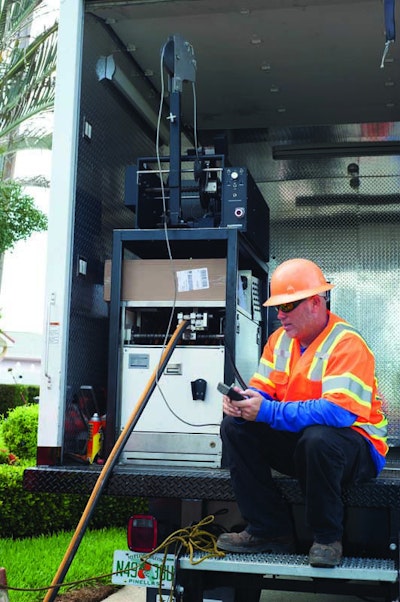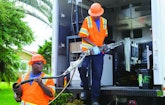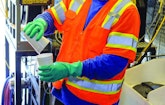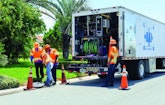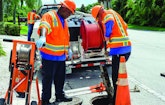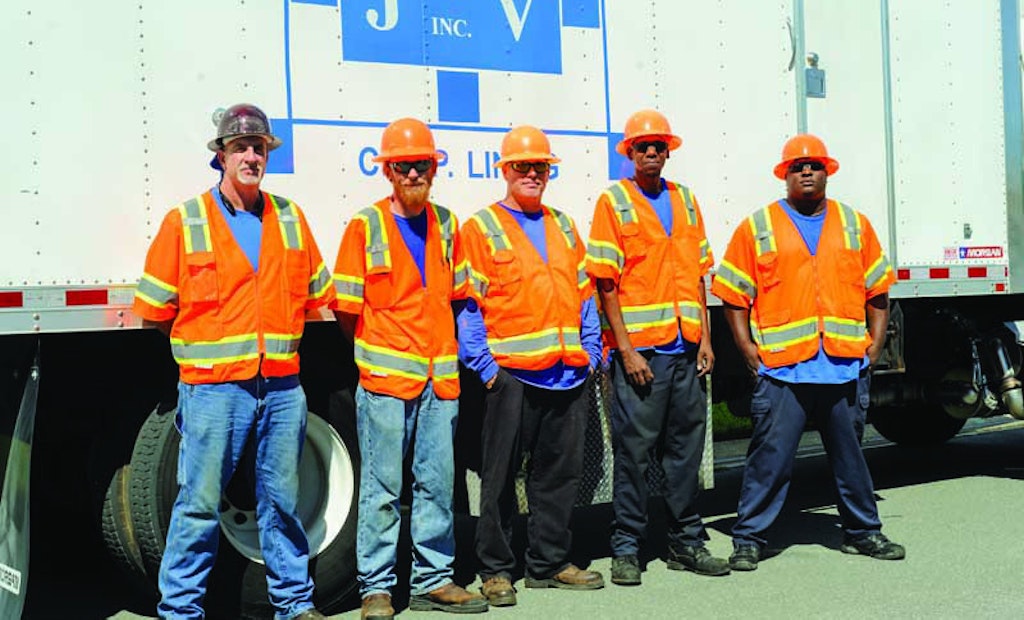
Interested in Relining/Rehab?
Get Relining/Rehab articles, news and videos right in your inbox! Sign up now.
Relining/Rehab + Get AlertsJoyce T. Velitschkowski is bullish on the trenchless rehabilitation market, and her quarter century in the business gives her a realistic perspective.
The president and project manager of JTV Inc. is quick to share her take on the industry’s future: “For trenchless technology companies I think it’s going to be the golden age, because our national infrastructure is generally anywhere between 40 to 75 years old. It can’t be ignored much longer. We’re going to continue to see catastrophic failures of underground utilities.”
She’s earned the right to make such bold prognostications, having fought her way from being a young woman on her own in an overwhelmingly male field that didn’t take her seriously, to owning and operating one of the most venerable and respected CIPP lining outfits in the southeastern United States.
Velitschkowski runs two mainline CIPP crews that each bill $3.5 million annually, and is about to launch a third focused on lateral lining. It was added after years of increasing customer requests, and plenty of research into feasible return on investment. She finally took the plunge when some contracts opened up in late 2015, making the equipment and labor expenditure a good risk.
Equipment matters
These days, JTV runs a full complement of serious professional vehicles and equipment to support its inspection, cleaning and rehabilitation work. Two R.S. Technical Services trucks carry the majority of the load. The first is a 2013 24-foot Hi-Cube box truck, outfitted with an RST TrakSTAR camera with on-screen diagnostics, TranSTAR steerable transporter with motorized camera lift, an OmniSTAR Probe camera with Mighty Mini Tractor, and a single-conductor universal tap-cutting control module. The latter is capable of operating their multiconductor tap-cutting system on the vehicle’s existing single-conductor mainline cable, eliminating the need for a secondary reel of multiconductor cable. This truck also carries Telespector grouting equipment.
A 2015 Freightliner with 24-foot Hi-Cube box carries two RST TrakSTAR cameras with on-screen diagnostics, two TranSTAR steerable transporters with motorized camera lifts and an Aries Wolverine lateral cutting system. A third RST camera truck will be added this year, outfitted with a TrakSTAR camera and steerable storm drain transporter to handle inspections in lines 24 inches and larger and their increasing pipeline inspection workload.
This is augmented with three Pearpoint P494/P420 mainline camera crawler systems for 6- to 24-inch lines, one P494/P448 24- to 120-inch mainline camera crawler system, one P-350 mini tractor camera crawler system, and three P340+ mini cameras.
“Before long — probably by the end of next year — we’ll have five RST systems,” Velitschkowski says. She likes the security of redundant systems, and favors RST equipment for the durability of its double-steel-armored, single-conductor cable. “The ability to quickly and easily re-terminate in the field is a nice benefit of the single-conductor system.”
Humble beginnings
This top-of-the-line fleet is a long way from what Velitschkowski had the first time she attended the Pumper Cleaner Environmental Expo (now the WWETT Show), and that’s another reason she’s an RST loyalist.
“They were the only vendor at that show who took me seriously as a contractor,” she recalls. “I stood for some time in the booth of one of the big players, and they never even acknowledged me. They lost all my business because of that. They’ve come knocking on my door a few times since then, and it’s like: ‘No thanks, you didn’t have time for me then, I have no interest in your business now.’”
In 1991, Velitschkowski was a systems software engineer for a bank. “I’d worked in the industry for eight years and hit the glass ceiling,” she says. Her father was in open-cut construction, and she went to lunch with him one afternoon, watching a CCTV crew perform a post-installation inspection. “It didn’t look like rocket science, so I did some research to find out if there was enough business to justify another startup in our market … and decided to go for it.”
Primarily, she was going after new construction in the DOT market. “I put a business plan together and went to seven banks,” she says. “I was laughed at because I was 28, female, and wanted to go into this heavy construction field.” None of the mix of big banks and smaller community institutions would grant her financing to purchase equipment. “So I scraped together $65,000 by putting a second mortgage on my house and maxing out four credit cards. That’s what I started with.”
She completed incorporation paperwork, found a small trailer-mounted, black-and-white inspection camera system, and began phone-prospecting for subcontracting jobs. “I started by blowing a tagline into the sanitary line and manually winching the camera through it,” she remembers. “It was quicker than trying to use a pushrod. I did it that way about two years, and (all profits) went back into the business, with just myself and a laborer. By doing that, I was able to save up enough to put a down payment on a robotic camera vehicle and a jet/vac truck.”
This investment allowed her to go after larger jobs, and soon thereafter, JTV was awarded its first municipal sewer cleaning and inspection contract.
Shifting gears
For three years, JTV hummed along with its newer equipment (bought used), inspecting and cleaning sewer mains before and after rehabilitation and maintenance projects.
After five years of seeing mainline sectional lining jobs, Velitschkowski believed she understood the process well enough to begin offering the service. Again, she dedicated herself to researching available products, deciding on a system of AOC polyester resin and Layne Inliner needled felt lining products.
That choice was driven mostly by the extremely high Florida water table, where nearly the entire state sits just above sea level. “Steam and UV have had a very hard time in Florida because of the high water table and the amount of infiltration,” Velitschkowski explains.
About four years later, the lining runs were getting longer and she needed to purchase lateral reinstatement cutting equipment. She was also beginning to bid on larger-diameter jobs, and the wet-out process was becoming unwieldy.
“We were doing 150-foot sectional jobs, which is tough, but you can still do it with a barrel-mixing method.” But it was time to kick up the productivity, so she bought a used wet-out table and moved to a static mixer. “That process allowed us to make the jump to full-length lining,” she explains. “With barrel mixing, you’re limited by ambient temperature and the mix time before the resin starts to activate. The static mixer allowed us to process up to 1,200-foot sections of liner and load it straight into a refrigeration truck. It really streamlined the production schedule and increased productivity 75 percent.”
She also invested at that time in grouting equipment. Like every other carefully considered expansion, this addition was a natural outgrowth of JTV’s core services. It built on previously established skills and allowed the company to efficiently promote the new service to current customers. This gave the company a larger slice of the contracting pie on many jobs that would otherwise have been smaller and less lucrative. This economy of scale is what Velitschkowski would leverage time and again in the gradual building of her company’s profitability and success.
New challenges
Eventually, Velitschkowski had a difficult decision to make. She was ready to approach the market as a primary contractor, but knew it would cause friction with her materials manufacturer. If she moved into the position of a potential competitor for larger jobs, she knew she would no longer get any more subcontracting work — her company’s bread-and-butter.
But this bird was ready to leave the nest. She spoke with three municipalities, with whom she worked extensively, to discuss her chances for success on her own. “I had to find out: If I make this jump, do I have your support? Will I be allowed to compete? Because in Florida (many of the larger municipalities) have contract clauses requiring a minimum of 1 million feet (of liner installed) in the state, or you can’t compete.”
One big break
Fortunately for JTV, those municipal customers were willing to waive that stipulation based on her company’s reputation for being reliable, easy to work with and quality-conscious. There was also another, very important factor working in JTV’s favor.
“It’s local representation, the fact that we’re right here. This is our tax base, and the money we’re paid is going right back into our community. We could offer faster turnaround time because we stock the material, and own and operate our wet-out facility. So if they ended up having a problem or time is an issue, our liner didn’t have to come from a factory, or go into a queue to work its way through an out-of-state wet-out facility.”
This local identity has also helped JTV get tapped for emergency response work in the wake of natural disasters, though the company isn’t on the list of government-approved contractors. “Municipalities have to have contractors they can depend on if we have a hurricane and lose power to the lift stations. We have to set up bypass pumps. Our local identity was again a big factor in getting the preapproved status requirement waived, because we can respond on a timely basis.”
Important critical analysis
Velitschkowski’s investment in the trenchless rehabilitation side of her business exceeded $2 million, but she emphasizes that none of it came out of the business. She was married when she launched the business, so she and her husband both lived on his salary for the first five years she was building JTV.
“All my pay, everything that I could’ve taken out as a stockholder, went back into the company for capital investment.” She consistently reinvested profits in her equipment so those expenses didn’t come off the bottom line. She also didn’t waste money on vanity, and purchased strategically.
“You have to put it into perspective: I didn’t start with all-new equipment. I would go to auctions and find a used wet-out table. And the barrel mixing led us to a new static mixer, because it is a huge investment.” This frugality and delayed gratification paid off.
“After I’d been in it a few years, I found a local community bank to work with me. I would put 10 percent down, then we’d have a moderately long term to pay it off, between five and 10 years. That’s the way I built it up. If I hadn’t developed that banking relationship, I would not have been able to make the growth happen without a long-term relationship.”
Strategic capital investment
JTV Inc. president and project manager Joyce T. Velitschkowski is the first to admit that it would be much more difficult today to build a company the way she did.
“Due to today’s equipment costs, it wouldn’t be possible, because in 1991, when I bought my first jet truck, it cost $181,000. Now they’re pretty close to $500,000 by the time you outfit it with all the safety equipment and quality nozzles. Therefore, in today’s market it would be very hard for a startup to go into CIPP unless they have substantial financial backing.
“Even used equipment is expensive, and it’s a fine line because you don’t really know the integrity of the equipment you’re buying. It can look great at an auction site, but is it going to run full time or under a full load? I did that in the beginning because I had to, but what I’ve found over time is that I sort of over-invest. I make sure I purchase equipment that has the most durability, because you have to make it last.”
She also has a traditional metal lathe and a CNC lathe and mill, and employs a full-time mechanic to keep her vehicles and heavy equipment in good repair. “I gave up trying to do our own camera repair. That kind of equipment has gotten so technically complicated it’s just not realistic to think you can repair it yourself anymore.”
She did investigate related service offerings including pipe bursting and manhole lining, but came to the conclusion they just didn’t fit well with her crew and business model. So JTV remains firmly niched in the inspection, cleaning, grouting and CIPP trenchless rehabilitation channel.
She stays attuned to her market by doing all her own sales and project management, leveraging the efficiencies of digital technology to create inspection reports and handle administrative data.
“I think my biggest achievement is longevity and quality. It’s a lot of hard work and a lot of dedication; not just mine, but the employees’ dedication. Sometimes things do go wrong, but the important thing is, if you have a problem, fix it. Don’t try to hide anything. Don’t try to cover it up. Make it right to sustain quality and communicate with the client.”
